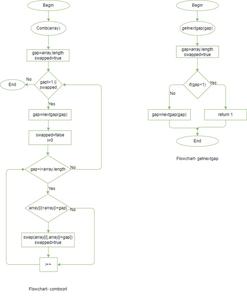Comb Sort
Last Updated :
19 Jun, 2023
Comb Sort is mainly an improvement over Bubble Sort. Bubble sort always compares adjacent values. So all inversions are removed one by one. Comb Sort improves on Bubble Sort by using a gap of the size of more than 1. The gap starts with a large value and shrinks by a factor of 1.3 in every iteration until it reaches the value 1. Thus Comb Sort removes more than one inversion count with one swap and performs better than Bubble Sort.
The shrink factor has been empirically found to be 1.3 (by testing Combsort on over 200,000 random lists) [Source: Wiki]
Although it works better than Bubble Sort on average, worst-case remains O(n2).
Flowchart

Flowchart
Below is the implementation.
C++
#include<bits/stdc++.h>
using namespace std;
int getNextGap(int gap)
{
gap = (gap*10)/13;
if (gap < 1)
return 1;
return gap;
}
void combSort(int a[], int n)
{
int gap = n;
bool swapped = true;
while (gap != 1 || swapped == true)
{
gap = getNextGap(gap);
swapped = false;
for (int i=0; i<n-gap; i++)
{
if (a[i] > a[i+gap])
{
swap(a[i], a[i+gap]);
swapped = true;
}
}
}
}
int main()
{
int a[] = {8, 4, 1, 56, 3, -44, 23, -6, 28, 0};
int n = sizeof(a)/sizeof(a[0]);
combSort(a, n);
printf("Sorted array: \n");
for (int i=0; i<n; i++)
printf("%d ", a[i]);
return 0;
}
|
Java
import java.io.*;
public class CombSort
{
int getNextGap(int gap)
{
gap = (gap*10)/13;
if (gap < 1)
return 1;
return gap;
}
void sort(int arr[])
{
int n = arr.length;
int gap = n;
boolean swapped = true;
while (gap != 1 || swapped == true)
{
gap = getNextGap(gap);
swapped = false;
for (int i=0; i<n-gap; i++)
{
if (arr[i] > arr[i+gap])
{
int temp = arr[i];
arr[i] = arr[i+gap];
arr[i+gap] = temp;
swapped = true;
}
}
}
}
public static void main(String args[])
{
CombSort ob = new CombSort();
int arr[] = {8, 4, 1, 56, 3, -44, 23, -6, 28, 0};
ob.sort(arr);
System.out.println("sorted array");
for (int i=0; i<arr.length; ++i)
System.out.print(arr[i] + " ");
}
}
|
Python3
def getNextGap(gap):
gap = (gap * 10)//13
if gap < 1:
return 1
return gap
def combSort(arr):
n = len(arr)
gap = n
swapped = True
while gap !=1 or swapped == 1:
gap = getNextGap(gap)
swapped = False
for i in range(0, n-gap):
if arr[i] > arr[i + gap]:
arr[i], arr[i + gap]=arr[i + gap], arr[i]
swapped = True
arr = [8, 4, 1, 56, 3, -44, 23, -6, 28, 0]
combSort(arr)
print ("Sorted array:")
for i in range(len(arr)):
print (arr[i],end=" ")
|
C#
using System;
class GFG
{
static int getNextGap(int gap)
{
gap = (gap*10)/13;
if (gap < 1)
return 1;
return gap;
}
static void sort(int []arr)
{
int n = arr.Length;
int gap = n;
bool swapped = true;
while (gap != 1 || swapped == true)
{
gap = getNextGap(gap);
swapped = false;
for (int i=0; i<n-gap; i++)
{
if (arr[i] > arr[i+gap])
{
int temp = arr[i];
arr[i] = arr[i+gap];
arr[i+gap] = temp;
swapped = true;
}
}
}
}
public static void Main()
{
int []arr = {8, 4, 1, 56, 3, -44, 23, -6, 28, 0};
sort(arr);
Console.WriteLine("sorted array");
for (int i=0; i<arr.Length; ++i)
Console.Write(arr[i] + " ");
}
}
|
Javascript
<script>
function getNextGap(gap)
{
gap = parseInt((gap*10)/13, 10);
if (gap < 1)
return 1;
return gap;
}
function sort(arr)
{
let n = arr.length;
let gap = n;
let swapped = true;
while (gap != 1 || swapped == true)
{
gap = getNextGap(gap);
swapped = false;
for (let i=0; i<n-gap; i++)
{
if (arr[i] > arr[i+gap])
{
let temp = arr[i];
arr[i] = arr[i+gap];
arr[i+gap] = temp;
swapped = true;
}
}
}
}
let arr = [8, 4, 1, 56, 3, -44, 23, -6, 28, 0];
sort(arr);
document.write("sorted array" + "</br>");
for (let i=0; i<arr.length; ++i)
document.write(arr[i] + " ");
</script>
|
Output
Sorted array:
-44 -6 0 1 3 4 8 23 28 56
Illustration:
Let the array elements be
8, 4, 1, 56, 3, -44, 23, -6, 28, 0
Initially gap value = 10
After shrinking gap value => 10/1.3 = 7;
8 4 1 56 3 -44 23 -6 28 0
-6 4 1 56 3 -44 23 8 28 0
-6 4 0 56 3 -44 23 8 28 1
New gap value => 7/1.3 = 5;
-44 4 0 56 3 -6 23 8 28 1
-44 4 0 28 3 -6 23 8 56 1
-44 4 0 28 1 -6 23 8 56 3
New gap value => 5/1.3 = 3;
-44 1 0 28 4 -6 23 8 56 3
-44 1 -6 28 4 0 23 8 56 3
-44 1 -6 23 4 0 28 8 56 3
-44 1 -6 23 4 0 3 8 56 28
New gap value => 3/1.3 = 2;
-44 1 -6 0 4 23 3 8 56 28
-44 1 -6 0 3 23 4 8 56 28
-44 1 -6 0 3 8 4 23 56 28
New gap value => 2/1.3 = 1;
-44 -6 1 0 3 8 4 23 56 28
-44 -6 0 1 3 8 4 23 56 28
-44 -6 0 1 3 4 8 23 56 28
-44 -6 0 1 3 4 8 23 28 56
no more swaps required (Array sorted)
Time Complexity: Average case time complexity of the algorithm is ?(N2/2p), where p is the number of increments. The worst-case complexity of this algorithm is O(n2) and the Best Case complexity is O(nlogn).
Auxiliary Space : O(1).
Snapshots:






Other Sorting Algorithms on GeeksforGeeks/GeeksQuiz
Selection Sort, Bubble Sort, Insertion Sort, Merge Sort, Heap Sort, QuickSort, Radix Sort, Counting Sort, Bucket Sort, ShellSort, Pigeonhole Sort
Like Article
Suggest improvement
Share your thoughts in the comments
Please Login to comment...